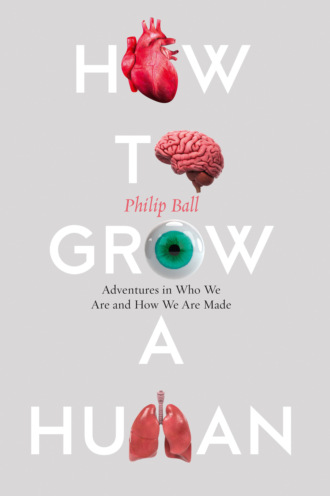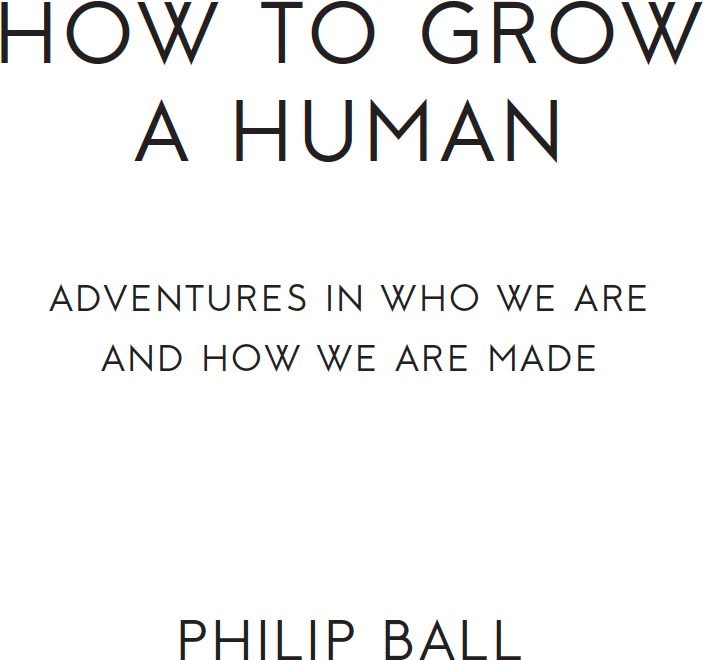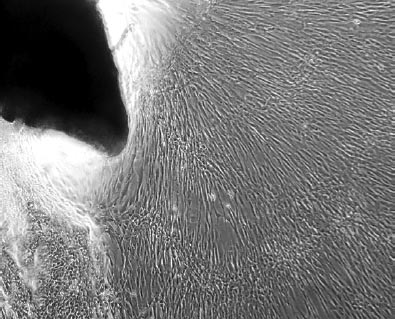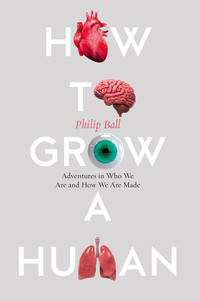
Полная версия
How to Build a Human: Adventures in How We Are Made and Who We Are




Copyright
William Collins
An imprint of HarperCollinsPublishers
1 London Bridge Street
London SE1 9GF
WilliamCollinsBooks.com
This eBook first published in Great Britain by William Collins in 2019
Copyright © Philip Ball 2018
Images © Individual copyright holders
Philip Ball asserts the moral right to be identified as the author of this work.
A catalogue record for this book is available from the British Library.
All rights reserved under International and Pan-American Copyright Conventions. By payment of the required fees, you have been granted the non-exclusive, non-transferable right to access and read the text of this e-book on-screen. No part of this text may be reproduced, transmitted, down-loaded, decompiled, reverse engineered, or stored in or introduced into any information storage and retrieval system, in any form or by any means, whether electronic or mechanical, now known or hereinafter invented, without the express written permission of HarperCollins.
Source ISBN: 9780008331771
Ebook Edition © May 2019 ISBN: 9780008331795
Version: 2019-05-20
CONTENTS
COVER
TITLE PAGE
COPYRIGHT
PROLOGUE
INTRODUCTION My Brain in a Dish
CHAPTER 1 Pieces of Life Cells past and present
CHAPTER 2 Body Building Growing humans the old-fashioned way
FIRST INTERLUDE The Human Superorganism How cells became communities
CHAPTER 3 Immortal Flesh How tissues were grown outside the body
SECOND INTERLUDE Heroes and Villains Cancer, immunity and our cellular ecosystem
CHAPTER 4 Twists of Fate How to reprogramme a cell
CHAPTER 5 The Spare Parts Factory Making tissues and organs from reprogrammed cells
CHAPTER 6 Flesh of My Flesh Questioning the future of sex and reproduction
CHAPTER 7 Hideous Progeny? The futures of growing humans
THIRD INTERLUDE Philosophy of the Lonely Mind Can a brain exist in a dish?
CHAPTER 8 Return of the Meatware Coming to terms with our fleshy selves
FOOTNOTES
ENDNOTES
BIBLIOGRAPHY
PICTURE CREDITS
INDEX
ACKNOWLEDGEMENTS
ABOUT THE BOOK
ABOUT THE AUTHOR
ABOUT THE PUBLISHER
PROLOGUE
This book arose from an astonishing experiment in which I was invited to take part, and which involved the transformation of a piece of me.
In the course of writing it, as I spoke to scientists about cell biology and fertility, embryology and medicine, philosophy and ethics, it dawned on me just how much science, in these fields especially, is driven by stories.
I don’t mean “human stories” – those tales about people that are said to be so central to keeping general audiences engaged. I mean that our perception of what science means is shaped by narratives about it. There are narratives that society imposes on new discoveries and advances, which are often cut from older cloth. In biology – particularly developmental, cell and reproductive biology – these stories tend to come from myth, science fiction and fantasy, and they are often alarming: they might, for example, draw on Frankenstein, Brave New World, The Island of Doctor Moreau. But there are also narratives that scientists themselves create and recycle. It happens more in the biological sciences than in the others because biology is inherently a science of becoming, where history matters and where we seem compelled to speak about goals and purposes: what organisms, cells and genes “want”, what evolution “seeks to do”.
A significant aspect of this book’s aim is to expose and explore these stories. They are by no means a bad thing. On the contrary, they are essential and often illuminating, for they fit with the way we humans make sense of our world, with our instinct to look for and find causation, reasons behind things. Yet there is a danger to them too, which is that we might begin to mistake them for descriptions of how things are.
One of the classic examples of a framing narrative in biology is Richard Dawkins’s concept of the selfish gene. Dawkins has had to defend this idea against accusations that it attributes a kind of agency and intention to genes, for it is of course just a metaphor. The problem is that, when a metaphor gets this popular, it starts to be understood (and sometimes presented) as a plain account of “what things are like”. When Dawkins speaks of us – individual humans – as the “survival machines” for genes, he is not defining what a human is but is explaining what we are required to be within the narrative of the selfish gene. The narrative serves to convey a particular aspect of how genes function in evolutionary terms. If you don’t like this story, or don’t find it helpful, you are not obliged to accept it; there is nothing “real” about it. Dawkins has said as much: he admits in The Selfish Gene that it should strictly be called The Slightly Selfish Big Bit of Chromosome and the Even More Selfish Little Bit of Chromosome. (He was right to suspect the book would not have been so successful if he’d called it that.) He even admitted much later that the book could equally have been titled The Cooperative Gene. That would have been a different narrative, of course, and it would have served to illustrate another facet of how genes work.
As Dawkins implicitly acknowledges here, biology is too complex and complicated to be reduced to a single story. That’s precisely why we need stories to tell about it: they give us something to cling to, some way of finding a path through the thicket. There is almost always more than one of them.
It’s not just, though, that we must remember this is what we are doing. We must also keep in mind that stories are not neutral vehicles for understanding. When we frame some medical advance within the narrative of Brave New World, we are not simply saying, “hey, doesn’t this sound a bit like the people-growing hatcheries in Aldous Huxley’s book!”, but also “… and we should be suspicious, even frightened, of where it might lead.” Precisely the same applies to The Selfish Gene. The story’s subtext here is that Darwinian evolution is ruthless – that it makes for a dog-eat-dog world, a battle for survival from the bottom up. Dawkins explains that this does not imply that humans are themselves bound to be selfish; indeed, he shows how altruism can arise from “selfish genes”. But the implication remains that there is to nature a redness in tooth and claw, and indeed Dawkins advises that for this very reason we should strive to supersede the default and be kind to one another. The point is, though, that one can talk about Darwinian evolution and genes without invoking “selfishness” at all, and the story then has a different complexion in which all manner of behaviours appear not as emergent and perhaps counter-intuitive consequences of a selfish genetic strategy but simply as aspects of the complexity of biology: cooperation as well as the most beastly predation strategies, war and peace, love and cruelty. Each of those words is equally freighted with narratives that biology itself doesn’t impose.
This is why I will be constantly alert to the narrative, and will ask, “why this story, and not some other?” Whether we are talking about cancer or immunity, cell signalling or tissue engineering, the science becomes packaged right from the outset inside a story, and this means that we impute agency, make choices about what to include and what not to, and suggest certain goals and not others. Even scientists speaking to other scientists need to use metaphors and narratives somewhere along the road, to give the mind purchase on concepts that are otherwise too slippery and too complex to comprehend. The only danger in all this, as in stories about “selfish genes”, is if we tell ourselves that all we are doing is relating objective truths.
I’d suggest that you might want to be alert to the narratives that I shall deploy too – for I am no more immune than anyone else to the tendency, the need, to tell a story, and the habit of using framing devices unconsciously. Challenge me on it. I promise to try not to mind.
It’s for this reason too that I think it is always important to know something about the historical context in which a scientific idea has arisen. We will see that, for example, cell theory was originally deemed to have a political dimension, and tissue culture was driven by social agendas. Some scientists might say, “oh, but that was then, and we have shed that baggage now and are dealing just with plain facts.” But I suspect that few scientists working on fertility and infertility would say this, and certainly they should not. They know very well that whatever they discover will be refracted through a complex social legacy of attitudes to baby-making, sex and gender. Geneticists labour under the shadow of the field’s eugenic past, and this goes beyond the stark fact that such work once led to enforced sterilization of the “unfit” in many countries and was embraced by the Nazis. Unease and dispute remain today over the implications of genetics for incendiary issues like race, class, intelligence and disability. What this means is that culture, past and present, may shape the scientific questions we ask, the models we develop, and the stories we tell.
I know from experience that there is a kind of reader who says, “I don’t care about that, just give me the science!” If you are that kind of reader, I’d humbly reply: I cannot give you “just the science”, because it already comes with a story attached. In this field – which I find breathtaking, perplexing, occasionally disturbing – there is never “just the science”.
When we ask, “how to grow a human”, we cannot possibly be asking “just” a question about science. That’s what makes the question so interesting.
INTRODUCTION
MY BRAIN IN A DISH
In the summer of 2017, a small piece of my arm was removed and turned into a rudimentary miniature brain. This book is my attempt to make sense of that strange experience.
On a hot day that July, I lay on a bed in the Institute of Neurology at University College London while neuroscientist Ross Paterson gouged a little chunk from my shoulder with a kind of miniature surgical apple-corer. A dab of local anaesthetic made it painless; to my great relief, there wasn’t much blood.
Bathed in a nutrient solution in a test-tube, that piece of my flesh was the seed for what, eight months later, would resemble a tiny brain.
It was my own “mini-brain”, a blob of neurons about the size of a lentil. They wired themselves into a dense network and could signal to one another in the way neurons do. I’m not going to say it was thinking; probably these signals were not much more than random sparks, incoherent noise, signifying nothing. But no one really knows how to think about what goes on inside a mini-brain, any more than they know what transpires in the formative brain of a fetus when it is of comparable pea-size.
This process of culturing new tissues from a piece of arm is not the way to create a human. But it could one day become a basis for doing that.
It’s not obvious why anyone, here and now, would think this a good idea. But the point is not that one day humans will, like the citizens of Aldous Huxley’s Brave New World, be cultivated from blobs of cells in the vats of some dystopian people-factory. The point is that such a vision is no longer obviously impossible. That alone should give us cause to revise our ideas about what we think we are. Having a piece of you grown into a mini-brain in an incubator five miles across town brings home to you, rather viscerally, why the need for that revision is upon us now.

My mini-brain under the microscope.
* * *
Let me explain.
My mini-brain was cultivated, nurtured and guided by neuroscientists Selina Wray and Christopher Lovejoy at UCL. That’s their job. They want to understand how brains develop, and in particular why some gene mutations send that process awry and trigger the onset of neurodegenerative diseases such as Alzheimer’s. These conditions, which many of us will confront – close to a million people in the UK are currently thought to be living with some form of dementia – are partly a consequence of ageing, but they can also have genetic roots. Some gene mutations confer particular susceptibility to dementias, and there are inheritable early-onset dementias that can affect people even in their thirties. My “brain in a dish” was grown as part of a large and ambitious project called Created Out of Mind, funded in 2016–18 by the Wellcome Trust to alter public perceptions of dementia and develop new tools for assessing the value of arts-based interventions for people living with these conditions.
Selina and Chris hope that, by studying the activity of genes in mini-brains cultured from the tissues of people with those genetic mutations, they might come to understand more about the causes, and ultimately find clues that could lead to possible cures. Scientists studying the genetic factors behind the neurodegenerative Huntington’s disease have already found that the baleful effect of one particular gene implicated in the condition can be tempered with drugs that intercept the conversion of the gene to a protein that is prone to “misfolding”. It’s this misfolded form that produces scarring and destruction of brain tissue. Others are working on vaccines that might prevent or remove the clumps of misfolded protein in the brain that seem to trigger Alzheimer’s itself.
To my knowledge, I do not have genes that make me susceptible to early-onset Alzheimer’s. But the aim of the Brains In A Dish project, coordinated by artist Charlie Murphy, was to explore and explain research like this through the response of its participants. Well, this book is mine.
I should be very clear what this term “mini-brain” implies. Some researchers reject it, and I see their point. Human neurons grown in a cell culture in this way can’t make a brain, not even in its early fetal form. But these nerve cells do start to create, under the direction of their own genetic programme, some of the features that a real developing brain exhibits. They become specialized into some of the many different cell types – not just neurons – that are found in our mature brains. And they acquire some of the anatomical structure of brains: the well-defined layers of neurons seen in the cortex, the folds and convolutions of the tissues. It’s rather like a very young child’s drawing of a person: not much of a resemblance really, but you can see what they’re getting at. You can see the potential to do a better job. A more neutral term for these lab-grown cell structures is “organoid”: the cells construct something that looks like a crude representation of an organ of the body, reduced in scale. It is possible to grow organoids resembling livers, kidneys, retinas, gut, as well as brains – all in a dish, outside the body. I want to ask what this means, for medicine, fundamental biology, philosophy and our sense of identity.
There was no rulebook to tell me how I should feel about my mini-brain. Certainly, I didn’t lie awake at night fretting over its welfare; this mass of tissue made from my skin didn’t take on the status of an individual. But I felt oddly fond of those cells, doing their best to fulfil a role in the absence of the guiding influence of their somatic source.1 There was a curious intimacy involved, a sense of potential that wasn’t present initially in the tiny chunk of arm-flesh excised and placed in a test-tube. This was more than a matter of cells subsisting; this was life in all its teeming, multiplying glory, spilling out from a paring of me.

My skin cells (fibroblasts) growing in a petri dish (in vitro) from a piece of skin tissue taken from my arm.
It’s hard not to invest the whole of biology with intentions, purposes, wants and needs, even though cells and simple organisms resemble automata responding without volition to the signals from their environment. (Some would say this applies to humans too.) That’s just how nature works.
Yet seeing these cells do their business in a petri dish is to recognize that life exists in doing. It is a process in which change is the only constant: change imbued with direction, more or less constrained onto a trajectory that evolution has guided and given what looks almost indistinguishable from a purpose, until death makes that change an inexorable slide into decay and entropic dissolution. There is no agreed scientific definition of “life”, but such a thing (if it is possible at all) would mean little if it fails to acknowledge this dynamic aspect, this interplay of predetermined pattern and historical contingency. It feels banal to say that my excised cells took on a life of their own, but what is so new and so remarkable about the science behind organoids is that we have the knowledge and power to influence the direction that life takes.
* * *
What really needs explaining is that my mini-brain was grown from a piece of my arm: in essence, from skin cells. That doesn’t sound like something that should be possible. Until barely more than a decade ago, most biologists thought so too. The discoveries that changed this view have transformed cell biology, raising all manner of medical possibilities for regenerating organs and tissues as well as opening up new avenues for basic research into embryology, development and conception. These discoveries and their applications are at the heart of this book.
But although these cell-transforming technologies have been celebrated, sometimes in breathless and hyperbolic terms, in the popular press, I’m not at all sure that their wider philosophical, one might even say psychic, implications have been acknowledged. Here is one of the profound things they say to us:
Every part of ourselves can potentially be turned into any other part of ourselves – including a complete self.
This, let me add, is more than science has yet proved. There is some small print attached, and further ingredients might be needed to fulfil the last part of the bargain. All the same, we are more plastic than we ever guessed. And that realization is in turn a culmination of medical advances and discoveries that have taken place over the course of the past century, which too we have processed only in the manner that we always process discoveries we don’t know how to think about. That’s to say, we have framed it around fears, fantasies and fiction.
For example: perhaps my “brain in a dish” immediately invokes visions of Frankenstein. And I pointed you also towards Brave New World, that re-envisioning of Mary Shelley’s tale for the age of industrialization and mass culture. These two novels remain today the favourite, off-the-shelf points of cultural reference for biomedical advances that unsettle and boggle the mind. But we are sent back to other speculative fictions by some of the possibilities that I have seen seriously and soberly discussed in the context of cell transformation and organoid growth. For example:
It may well be possible to grow a human brain in the body of a pig. One reason I find this so disturbing is that I still vividly remember first seeing the scene in Lindsay Anderson’s 1973 film, O Lucky Man!, where … well, if you don’t know it already, don’t let me spoil it for you.
It might be feasible to grow each organ of the human body separately outside the body itself in some sort of vessel (in vitro), and then surgically assemble them into a person – or enough of a person to be, let’s say, a personoid. And this is precisely how the first robots were made, in Karel Čapek’s 1921 play, R.U.R.
Philosophers, ethicists and neuroscientists are now compelled to debate what it could mean to create a full-grown human brain in a vat. Could it be conscious? Would it experience a self-contained interior “reality”? The pop-culture reference point here, which philosophers have embraced with nerdy delight, is of course the Matrix movies of the Wachowskis.
Let me make it clear that no researcher sees any prospect of these things happening in the near future, nor any good reason to try to make them happen. I will look at them more closely later, but my point here is not to tell rather shocking and thrillingly grotesque scare stories in a bout of bait-and-switch. What matters is that, confronted with so disorienting and disturbing a set of imaginable possibilities, we seem to need such stories in order to frame our thoughts. That in itself is worth considering. What motivates and shapes these narratives?
Underpinning them, I believe, is a consideration that might at first strike you as odd: We are not at ease with our own flesh.
But surely, you might say, we inhabit our own flesh? I’m putting those words into your mouth because they have a familiar ring to them – it doesn’t seem a strange thing to suggest. Yet such a phrase serves more to disassociate than to unite us with our flesh. We inhabit it? Like a person who inhabits a house? So what, then, are “we”? It’s the old Cartesian dualism: the separation of mind and body, or as some might have once said, of body and soul.
Yet of course we are not at ease in our own flesh! How we recoil from its routine functions, its excrescences and smells and fluids. How hard we try to remodel it, with what horror we watch its decrepitude. How we flock to watch movies like Hellraiser and Saw, or, at the more sophisticated end of the body-horror market, pretty much any of David Cronenberg’s early oeuvre. Gunther von Hagens, with his plasticized corpses, has made a career from an artful exploration of our horrified fascination; artists from Mark Quinn (who has sculpted with his own blood and the placenta of his baby son) to Marina Abramović have made what are often brave, painful and stomach-churning attempts to help us engage with our raw material.
There are many reasons for this ambivalence towards the somatic aspects of human existence, expressed repeatedly in all cultures in all ages: with piercings and tattoos, rituals of embalming and burial, elaborate taboos and the normative strictures of surgery. But the new sciences of culturing and transforming our cellular fabric confront us with perhaps the most fundamental challenge for our relationship with our flesh. They show us the ultimate in dismemberment: a reduction of the person to the cell.
Time was when we could dismiss that. Sure, cells are our building blocks, but no more or less so than proteins, atoms or quarks. If a chunk of our cellular material were removed, well, so what? It was no longer “us”, but a piece of waste, separate and dead, soon to be putrescent and doomed by microbes and entropy.





